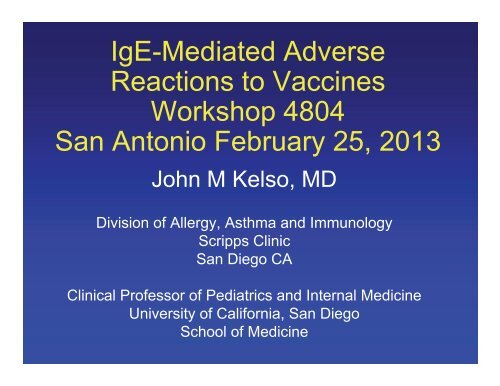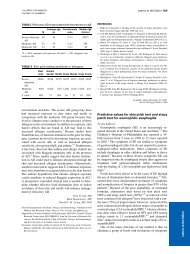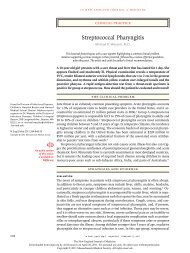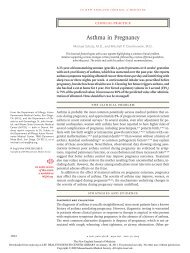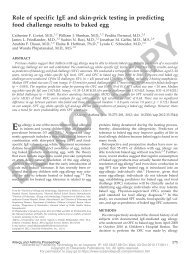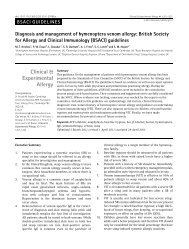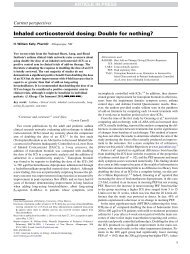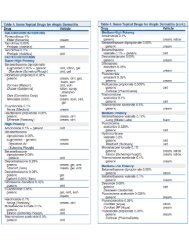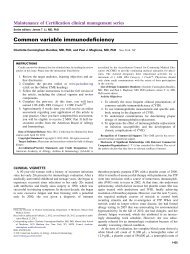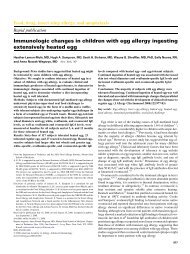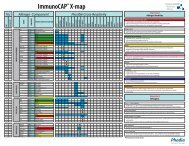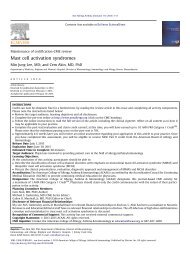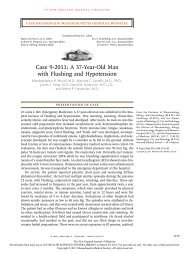IgE-Mediated Adverse Reactions to Vaccines Workshop ... - AInotes
IgE-Mediated Adverse Reactions to Vaccines Workshop ... - AInotes
IgE-Mediated Adverse Reactions to Vaccines Workshop ... - AInotes
Create successful ePaper yourself
Turn your PDF publications into a flip-book with our unique Google optimized e-Paper software.
<strong>IgE</strong>-<strong>Mediated</strong> <strong>Adverse</strong><br />
<strong>Reactions</strong> <strong>to</strong> <strong>Vaccines</strong><br />
<strong>Workshop</strong> 4804<br />
San An<strong>to</strong>nio February 25, 2013<br />
John M Kelso, MD<br />
Division of Allergy, Asthma and Immunology<br />
Scripps Clinic<br />
San Diego CA<br />
Clinical Professor of Pediatrics and Internal Medicine<br />
University of California, San Diego<br />
School of Medicine
Faculty Disclosure<br />
Information<br />
• I have not had a significant financial<br />
interest or other relationship with the<br />
manufacturers of the products or providers<br />
of the services that will be discussed in my<br />
presentation.<br />
•This presentation will not include discussion<br />
of pharmaceuticals or devices that have not<br />
been approved by the FDA, but will include<br />
some discussion of non-FDA approved skin<br />
test materials.
Objectives<br />
•Develop a diagnostic approach <strong>to</strong> the<br />
evaluation <strong>IgE</strong>-mediated reactions <strong>to</strong><br />
vaccines<br />
•Provide advice regarding the future<br />
administration of vaccines<br />
•Safely administer influenza vaccine <strong>to</strong><br />
egg-allergic recipients
<strong>Adverse</strong> reactions <strong>to</strong> vaccines<br />
practice parameter 2012<br />
update.<br />
Kelso JM, Greenhawt MJ, Li<br />
JT, et al.<br />
Journal of Allergy and Clinical<br />
Immunology 2012; 130:25-43.
Summary Statement 5. All suspected<br />
anaphylactic reactions <strong>to</strong> vaccines should<br />
ideally be evaluated in an attempt <strong>to</strong><br />
determine the culprit allergen.
• When a patient experiences an apparently<br />
<strong>IgE</strong>-mediated reaction after an immunization,<br />
often labeled “allergic” and advised against<br />
future doses<br />
• This approach should be avoided because it<br />
may leave patients inadequately immunized<br />
if they unnecessarily avoid vaccines <strong>to</strong> which<br />
they are not allergic or if the vaccine could<br />
be administered safely despite their allergy.<br />
• In addition, not knowing the constituent of a<br />
vaccine <strong>to</strong> which the patient is allergic may<br />
pose a risk with future vaccinations that<br />
contain the same ingredient.
Summary Statement 6. <strong>IgE</strong>-mediated<br />
reactions <strong>to</strong> vaccines are more often<br />
caused by vaccine components such as<br />
gelatin, rather than the immunizing agent<br />
itself.
Gelatin<br />
• Gelatin is added <strong>to</strong> many vaccines as a<br />
stabilizer<br />
• Gelatin in vaccines is bovine or porcine,<br />
which are extensively cross-reactive<br />
• Responsible for many anaphylactic<br />
reactions <strong>to</strong> MMR, varicella, and (the old)<br />
Japanese encephalitis vaccines.<br />
• A his<strong>to</strong>ry of allergy <strong>to</strong> the ingestion of<br />
gelatin should be sought before the giving<br />
a gelatin-containing vaccine; negative<br />
his<strong>to</strong>ry may not exclude an allergic<br />
reaction <strong>to</strong> gelatin injected with the<br />
vaccine.
• Persons who react <strong>to</strong> gelatin on<br />
ingestion should be evaluated by an<br />
allergist prior <strong>to</strong> administration of gelatincontaining<br />
vaccines.<br />
• If the his<strong>to</strong>ry is consistent with an<br />
immediate-type allergic reaction <strong>to</strong><br />
gelatin confirmed by skin tests or serum<br />
specific <strong>IgE</strong>, skin test with vaccines prior<br />
<strong>to</strong> administration.<br />
– If negative, give in usual manner but<br />
observe for 30 minutes afterward.<br />
– If positive, give vaccine in graded<br />
doses
Egg<br />
• Measles and mumps vaccines and one<br />
type of rabies vaccine are grown in chick<br />
embryo fibroblast cultures and contain<br />
negligible or no egg protein<br />
• Thus, MMR can be administered <strong>to</strong> egg<br />
allergic children without skin testing and<br />
without adverse reactions<br />
• Egg protein is present in higher amounts in<br />
influenza and yellow fever vaccines and<br />
could in theory cause reactions in egg<br />
allergic patients.
Influenza vaccine contains<br />
measurable quantities of egg protein<br />
(ovalbumin); does this cause systemic<br />
reactions when injected in<strong>to</strong> eggallergic<br />
patients<br />
• 28 published studies involving >4300 egg-<br />
allergic subjects getting influenza vaccine<br />
without any serious reactions (no<br />
respira<strong>to</strong>ry distress or hypotension), and<br />
with only a low rate of minor reactions<br />
(hives, mild wheezing).<br />
• So, the answer appears <strong>to</strong> be no.
But what about patients with severe<br />
egg allergy<br />
• Most studies have specifically included<br />
patients with his<strong>to</strong>ries of severe<br />
anaphylaxis (n = 656) with egg ingestion<br />
and these patients also <strong>to</strong>lerate the<br />
vaccine.<br />
• So, even these patients do not appear <strong>to</strong><br />
be at risk of serious reaction.
Why are there no serious reactions<br />
being reported<br />
• 3/4 manufacturers of injectable trivalent<br />
influenza vaccine (TIV) report the maximum<br />
amount of ovalbumin in the package insert<br />
and the other will provide the information on<br />
request.<br />
• The claimed amounts are all < 1 mcg per 0.5<br />
mL dose.<br />
• The measured amounts in independent<br />
labora<strong>to</strong>ries are usually much lower than the<br />
claimed amounts.
What about LAIV<br />
• Although the intranasally-administered<br />
live attenuated influenza vaccine (LAIV)<br />
contains a low amount of ovalbumin, all<br />
published studies <strong>to</strong> date have<br />
evaluated the injectable trivalent<br />
inactivated vaccine (TIV), and thus TIV<br />
rather than LAIV should be used for<br />
egg-allergic recipients.
What about cell culture derived TIV<br />
• A cell culture based influenza vaccine that<br />
does not contain any egg protein was<br />
approved by the FDA in November of 2012<br />
for use in patients 18 years of age and older.
What about cell culture derived TIV<br />
• If readily available, this vaccine would be<br />
preferred in egg-allergic adults. However,<br />
the opportunity <strong>to</strong> immunize an egg-allergic<br />
adult should not be missed if the cell culture-<br />
based vaccine is not readily available, in<br />
which case such patients should receive<br />
egg-based vaccine.
What about cell culture derived TIV<br />
• Studies of this vaccine in children are<br />
underway, however until they are completed,<br />
the vaccine should not be used in patients<br />
under age 18 because some influenza<br />
vaccines have been found <strong>to</strong> be less<br />
immunogenic in certain age groups and<br />
others have been found <strong>to</strong> have higher rates<br />
of adverse reactions in certain age groups,<br />
and the risk of the egg-based vaccines in<br />
egg-allergic patients is minimal.
“Other measures, such as dividing and administering the vaccine by a<br />
two-step approach and skin testing with vaccine, are not necessary”
Yellow Fever Vaccine<br />
• A his<strong>to</strong>ry of allergy after the ingestion of<br />
egg should be sought prior <strong>to</strong> the<br />
administration of yellow fever vaccine<br />
• Persons with positive his<strong>to</strong>ries should be<br />
skin tested with yellow fever vaccine prior<br />
<strong>to</strong> administration<br />
– If negative, give in usual manner but<br />
observe for 30 minutes afterward.<br />
– If positive, give vaccine in graded doses
Yeast<br />
• Hepatitis B vaccines are grown in<br />
Saccharomyces cerevisiae (baker’s yeast<br />
or brewer’s yeast) and contain residual<br />
yeast protein<br />
• However, adverse reactions <strong>to</strong> these, if<br />
any, appear <strong>to</strong> be rare<br />
• Human papillomavirus vaccine may also<br />
contain residual yeast protein
• Yeast allergy itself is very rare but, if a<br />
patient has a his<strong>to</strong>ry of clinical reactivity <strong>to</strong><br />
Baker's or Brewer’s yeast and a positive<br />
skin test <strong>to</strong> Saccharomyces cerevisiae,<br />
skin test them with yeast-containing<br />
vaccines prior <strong>to</strong> administration.<br />
– If negative, give in usual manner but<br />
observe for 30 minutes afterward.<br />
– If positive, give vaccine in graded doses
Latex<br />
• The “rubber” in vaccine vial s<strong>to</strong>ppers or<br />
syringe plungers may be dry natural<br />
rubber (DNR) latex or synthetic rubber.<br />
• Those made with DNR pose a theoretical<br />
risk <strong>to</strong> the latex allergic<br />
• A review of > 160,000 VAERS reports<br />
found only 28 cases of possible<br />
immediate-type allergic reactions after<br />
receiving a DNR-containing vaccine, and<br />
these may have been due <strong>to</strong> other<br />
components
• Latex content of vaccine packaging is<br />
provided is updated at:<br />
http://www.cdc.gov/vaccines/pubs/pinkbo<br />
ok/downloads/appendices/B/latextable.pdf
• Patients with latex allergy can safely<br />
receive vaccines from vials with non-DNR<br />
s<strong>to</strong>ppers.<br />
• If the only available preparation has a<br />
latex s<strong>to</strong>pper, the s<strong>to</strong>pper should be<br />
removed and the vaccine drawn up<br />
directly from the vial without passing the<br />
needle through the s<strong>to</strong>pper.<br />
• If the only available vaccine contains latex<br />
in the packaging that cannot be avoided,<br />
such as in a prefilled syringe, the vaccine<br />
can still be administered but the patient<br />
should be observed for at least 30<br />
minutes afterward.
Summary Statement 7. Patients who have<br />
had an apparent anaphylactic reaction<br />
after immunization should undergo<br />
immediate-type allergy skin testing <strong>to</strong> help<br />
confirm that the reaction was <strong>IgE</strong>mediated<br />
and determine the responsible<br />
component of the vaccine.
• To determine whether a vaccine was<br />
responsible for an apparent allergic<br />
reaction, skin test with the vaccine<br />
– first by prick method (full-strength<br />
unless his<strong>to</strong>ry truly life-threatening)<br />
– If negative, ID 1:100<br />
• As with any (especially nonstandardized)<br />
skin test reagent, false<br />
positive (irritant) and clinically irrelevant<br />
positive results may occur<br />
• Likewise, false-negatives also possible
• If the suspect vaccine contains gelatin,<br />
egg, latex or yeast, skin test for these<br />
• Egg and yeast extracts commercially<br />
available<br />
• Gelatin (not FDA-approved): dissolve 1<br />
teaspoon (5 g) of any sugared gelatin<br />
powder (e.g., Jell-O) in 5 mL of NS <strong>to</strong><br />
create a prick skin test solution<br />
• Latex (not FDA-approved): soak 2 fingers<br />
of latex glove or a <strong>to</strong>y balloon in 5 mL of<br />
NS <strong>to</strong> create a prick skin test solution<br />
• In vitro assays for specific <strong>IgE</strong> antibody<br />
commercially available for gelatin, egg,<br />
latex and yeast
Summary Statement 8. If the intradermal<br />
skin test result is negative, the chance<br />
that the patient has <strong>IgE</strong> antibody <strong>to</strong> any<br />
vaccine constituent is negligible, and the<br />
vaccine can be administered in the usual<br />
manner. It is prudent nonetheless, in a<br />
patient with a his<strong>to</strong>ry suggestive of an<br />
anaphylactic reaction, <strong>to</strong> administer the<br />
vaccine under observation with<br />
epinephrine and other treatment<br />
available.
• No formal studies <strong>to</strong> evaluate the positive<br />
and negative predictive values for<br />
vaccine skin tests<br />
• Dilutions of vaccines of 1:100 have been<br />
demonstrated <strong>to</strong> be nonirritating for<br />
intradermal testing<br />
• No reports of patients with negative<br />
intradermal skin test reacting <strong>to</strong><br />
subsequent administration of vaccine
Summary Statement 9. In patients with<br />
his<strong>to</strong>ries and skin test results consistent<br />
with an <strong>IgE</strong>-mediated reaction <strong>to</strong> a<br />
vaccine, who require additional doses of<br />
the suspect vaccine or other vaccines<br />
with common ingredients, consideration<br />
can be given <strong>to</strong> administering the vaccine<br />
in graded doses under observation.
• If vaccine or vaccine component skin<br />
test results are positive, the vaccine<br />
may still be administered, if necessary,<br />
in graded doses
Suggested approach <strong>to</strong> suspected<br />
adverse reaction <strong>to</strong> a vaccine
Summary<br />
• Patients with suspected allergy <strong>to</strong><br />
vaccines or vaccine components<br />
should be evaluated by an allergist<br />
• Most patients with suspected allergy <strong>to</strong><br />
vaccines can receive vaccination safely


